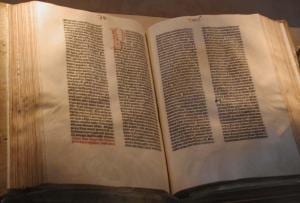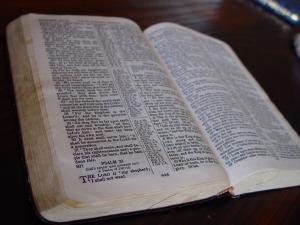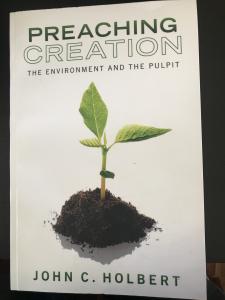
In the first installment of my ruminations on reading the Bible, something I have done joyfully and doggedly for 50 years, I discussed a few ideas concerning just what the Bible is and is not. Of course, much more could be said about that; I have by no means exhausted that subject but have barely scratched the surface. Today, I wish to turn to a subject that receives far too little attention when it comes to Bible reading: just who is it that is doing the reading? What effects does the identification of the reader have on the course of the reading? I want to say up front that the clear identity of the one reading has an enormous impact on the nature and content of the reading.
I am a 72-year-old white male with a 43-year old PhD in the study of the Hebrew Bible. Those are the basic facts about me, and they are telling in many ways. The fact that I am a male will determine some of the ways that I approach the text; I will provide a personal example below to make that point. The fact that I am Caucasian also contributes to the specific ways that I hear the text, how the text speaks to that part of who I am. In addition, my advancing age indicates that I was raised in a certain time in American history, that the Cold War, the sexual revolution, the Vietnam hot war, the Watergate debacle, the rise of the politics of the Evangelical right, each influenced my perceptions of the world, and thus gave me a certain way to perceive truth and a certain way to call nearly everything into serious question. My history trained me to look at all things somewhat askance, because not everything presented to me during my history was trustworthy.
But there is still much more to identify about me. I was a very early voluminous reader of novels and poetry. From the time I was barely in grade school I read Dickens and Austen and Melville, along with Emily Dickenson, T.S Eliot, William Carlos Williams, among many others. Indeed, one of Dickenson’s most memorable lines—“Tell all the truth you can, but tell it slant”—has been for me a defining mantra for the ways I read and express what I have learned from that reading. These great writers taught me that the world is never to be taken at face value, that all things are slightly askew, that things “are seldom what they seem,” as Gilbert and Sullivan sang it. So when I came to the Bible, the same dicta applied, and my typical questions were inevitably asked: Is Samuel only a pure prophet of God? Is David simply a “man after God’s own heart”? Can Saul be discarded as only a failed king? Is Eve really to blame for the affair of the garden? Hundreds of questions sprang to my mind as I read those texts, and as I read commentaries on those texts.
I promised a personal example of the vast importance of understanding oneself as reader, and here it is. I first encountered the tiny story of Ruth in my second year of graduate study. The book of Ruth is a good one to read after having a few years of Hebrew under one’s belt. The text is relatively without real difficulty, save some messiness in chapter 4 and its odd bit about exchanging sandals. It is classic Hebrew prose with a small vocabulary. And it is a decent story with a straightforward plot and a lovely and seemingly romantic denouement. And for good measure Ruth, the Moabite widow, turns out to be David’s great grandmother, thus adding a telling bit of information suggesting that foreigners should be treated well, notwithstanding those Bible stories where foreigners are seen as little more than scum to be destroyed.
I said it was a good story, and so it is. It appeared to me then in 1972 to be a tale worthy of a television soap opera, where the love story between Ruth, the foreign widow, and Boaz, the wealthy relative of Naomi, Ruth’s Israelite mother-in-law, is delightfully consummated after a slightly saucy tryst—completed orchestrated by Naomi and Ruth— on Boaz’ threshing floor at midnight. One can just hear the organ gently playing in the background! The class I was in was taught by a man, and among the other seven students was one woman. None of us, including the woman, could actually hear this story at all! The story of Ruth made little impact on any of us.
After finishing my degree in 1975, I was pastor of a church and preached perhaps 80 sermons; none of those took Ruth as the text. I then spent three years teaching undergraduates courses in introduction to the Hebrew Bible (though I and they called it the Old Testament in those days), and I cannot remember spending much time on Ruth; the story always was delegated to the scrap end of the semester along with Jonah and Daniel. My then late 20’s eyes were still closed to the magic of this book.
Then a read two pieces about Ruth, one by an English professor named D.F. Rauber (I know nothing more of his work), and the article in Phyllis Trible’s seminal book, God and the Rhetoric of Sexuality. From Rauber I began to see something of the subtleties of language employed in the book, and from Trible I gained at least a part of what her eyes as female taught her what the book was really about. In short, Ruth is not about the romantic love between Ruth and Boaz, but instead about the unbreakable love that Ruth held for Naomi despite Naomi’s despair and desire to rid herself of both of her daughters-in-law. The very famous speech that Ruth utters in direct response to Naomi’s cry for her to go home to Moab is far more than a nice little ditty sung at modern weddings; it is nothing less than a woman’s deepest desire to stay with and to support and to defend her mother-in-law no matter what. In short, Ruth’s actions mirror the actions of God in every significant way. One might say that in the story of Ruth, God is a Moabite widow, which by any reckoning is a patriarchal mouthful. I now see the tale of Ruth as one of the Bible’s great gems, loaded with ironies and blessed with a rich and inventive plot with a vital insight into human and divine actions.
My male eyes could never have seen these wonderful insights, even if I had developed the desire to look more closely at the book. How grateful I am to Rauber and Trible for these wonderful ways of seeing that have delivered to me a tale I now adore and one that nourishes me as a believer each time I read it.
I trust this tiny piece of my reading history will prove to you the crucial necessity of paying careful attention to oneself as the reader of the Bible. Just who are you as you read? I like to use the mage of the location of the Bible’s inspiration. Such inspiration is not to be found in the words themselves; surely one could memorize all of the Bible’s words and feel little or no inspiration from them. The Spirit of God strikes fire when a knowledgeable reader brings all she is to the text, and as text and person meet, some six inches above the pages, the Spirit may do its work. And what a grand work it can be!











